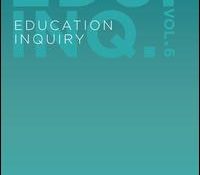eric.ed.gov har udgivet: This paper explores the pedagogy underpinning the use of laser manufacturing methods for the teaching of science, technology, engineering and mathematics (STEM) at key stage 3 design and technology. Clock making (horology) has been a popular project in design and technology (D&T) found in many schools, typically it focuses on aesthetical design elements. This paper describes a new project, which has been developed to enhance the STEM content of a horology project through advanced utilisation of laser cutting machinery. It allows pupils to produce their own products from self-made mechanical timing mechanisms. The central aim is to strengthen the application of the underlying technology of mechanisms and the manufacturing capability of laser cutting technology in D&T. Trials with schools have shown success in gaining pupils’ interest in… Continue Reading →
Like this:
Like Loading...
eric.ed.gov har udgivet: The conceptual foundation for remedial education is straightforward: students are tested to determine whether they meet a given level of academic proficiency for college-level classes. For those who do not meet this level, deficiencies in skills are addressed through some form of supplementary instruction, most often remedial courses. The study summarized in this Brief employs a quasi-experimental design to examine remedial enrollment and outcomes of community college students throughout the state of Florida. Results of the study suggest that as a means for addressing the needs of under-prepared students, remediation has both benefits and drawbacks. After controlling for noncompliance and endogenous sorting around the placement test cutoff score, students on the margin of requiring math remediation were slightly more likely to persist to their second year. Similarly,… Continue Reading →
Like this:
Like Loading...

tandfonline.com har udgivet en rapport under søgningen “Teacher Education Mathematics”: Abstract Abstract The National Association of Geoscience Teachers’ Workshop for Early Career Geoscience Faculty: Teaching, Research, and Managing One’s Career has been offered annually since 1999. The five-day workshop with accompanying web resources employs a “whole faculty” approach to support geoscience faculty members during their transition into academic careers. More than 1,000 faculty members (53% female, 47% male) have attended the national workshop; 52% from doctoral-granting institutions, 15% master’s, 28% bachelor’s, and 5% associates. Evidence-based instructional practices are shared and modeled during workshop sessions. Situated learning theory grounds the workshop design and promotes the development of a community of practice. Examination of the 2016 National Geoscience Faculty Survey data using univariate analyses of covariance (ANCOVAs) showed that workshop alumni report… Continue Reading →
Like this:
Like Loading...
eric.ed.gov har udgivet: This study ranked constructs articulated by Childress and Rhodes (2008) and identified the key indicators for each construct as a starting point to explore what should be included on an instrument to measure the engineering design process and outcomes of students in high schools that use the PLTW and EbDTM curricula in Idaho. A case-study design was used. Data were collected in two stages. In the first stage, a content analysis was conducted for PLTW and EbDTM curricula to identify the indicators that are associated with the six constructs articulated by Childress and Rhodes (2008). In the second stage, the constructs and key indicators or concepts were placed on a survey and sent to experts for them to rate their importance for assessment and their difficulty to… Continue Reading →
Like this:
Like Loading...
eric.ed.gov har udgivet: Guided by the Next Generation Science Standards and elements of problem-based learning, four human-environment systems simulations are described in brief–carbon, energy, water, and watershed–and a fifth simulation on nitrogen is described in more depth. These science, technology, engineering, and math (STEM) education simulations illustrate design principles that make them engaging to students, such as dynamic visual environments that are controlled by the user and immediate visual feedback to user actions taken. The simulations are contextualized in real-world natural resources management challenges involving biogeochemical cycles, such as Gulf of Mexico hypoxia, which provide an opportunity to “win the game,” while the introduction of complexity in steps provides scaffolding. Pretest versus posttest results indicate a substantial and statistically significant improvement in learning outcomes resulting from using the nitrogen simulation,… Continue Reading →
Like this:
Like Loading...
eric.ed.gov har udgivet: Increasing numbers of high schools are offering senior-year transition curricula in math and English to better prepare graduating students for college. These transition curricula are typically full-year, high school credit-bearing courses taken by students at risk of being placed into developmental (also known as remedial) courses upon enrollment in college. In many cases, students who successfully complete a transition course are officially designated as “college ready” and therefore bypass developmental education altogether. Educators who are interested in developing transition courses currently have limited information about how others have done so. Based on the experiences of those who have developed or overseen transition courses, this brief provides a typology of transition course design options for those thinking about how to best plan and implement these offerings. Among other… Continue Reading →
Like this:
Like Loading...
tandfonline.com har udgivet en rapport under søgningen “Teacher Education Mathematics”: ABSTRACT ABSTRACT In autumn 2016, Malmö University started two “fast track” trajectories for teachers with refugee backgrounds. The participants were offered an education of 26 weeks as an introduction to the Swedish school system, consisting of content courses, professional Swedish and workplace learning. The aim of this small explorative study was to get an impression of the participants’ views and understanding of the role of becoming a teacher in Swedish schools, realising the characteristics of pedagogy aimed for in the curriculum, specifically the interaction patterns and student participation in learning processes. Main research questions addressed participants’ expectations of differences and challenges in the Swedish school context as compared to their experiences in Syrian contexts. A combination was chosen of focus groups… Continue Reading →
Like this:
Like Loading...
tandfonline.com har udgivet en rapport under søgningen “Teacher Education Mathematics”: Link til kilde
Like this:
Like Loading...
tandfonline.com har udgivet en rapport under søgningen “Teacher Education Mathematics”: Abstract Evidence-informed policy and practice has been a trend as part of an effort to increase the use of research to improve education at all levels. In many countries, knowledge-brokering initiatives were established to stimulate links between research, policy, and practice. Drawing on a mapping of initiatives in seven countries, this article describes different organizational designs, and discusses potential dilemmas these might imply for the realization of these organizations’ roles. Given different interests involved, the article shows that organizational design is crucial for enhancing legitimacy. Findings indicate a trend toward locating the knowledge-brokering function in a combined policy–science logic. Link til kilde
Like this:
Like Loading...
tandfonline.com har udgivet en rapport under søgningen “Teacher Education Mathematics”: “Use what you have to secure what you have not”. On Design for and from Autonomy Link til kilde
Like this:
Like Loading...




